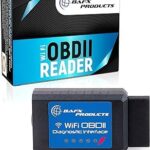Finding the OBD2 port on a 1997 Honda Odyssey can sometimes be tricky. This article provides clear guidance on locating the port, which is essential for diagnostics and troubleshooting. The OBD2 port, or diagnostic link connector (DLC), allows you to connect a scan tool to retrieve diagnostic trouble codes (DTCs) and monitor vehicle performance data.
Locating the OBD2 Port in a 1997 Honda Odyssey
The 1997 Honda Odyssey’s OBD2 port is typically located under the driver’s side dashboard, near the steering column. It’s often positioned above the foot pedals, towards the center of the vehicle. You may need to crouch down and look upwards to spot it. The port itself is a female, 16-pin connector, usually black or gray in color. It might be partially covered by a plastic panel or trim.
Tips for Finding the Port:
- Use a flashlight: Limited visibility under the dashboard can make the port difficult to see. A flashlight can help illuminate the area.
- Feel around: If visual inspection is challenging, try feeling around the area described above. The distinct shape of the connector should make it recognizable by touch.
- Consult the owner’s manual: While not always accurate, your Odyssey’s owner’s manual might provide a diagram or description of the port’s location.
Common Misconceptions:
Sometimes, metal brackets or other components under the dashboard can be mistaken for the OBD2 port. Remember, the OBD2 port is a 16-pin connector and will typically have a trapezoidal shape.
Why is the OBD2 Port Important?
The OBD2 port is crucial for vehicle diagnostics. Mechanics and car owners can use a scan tool to:
- Retrieve Diagnostic Trouble Codes (DTCs): DTCs indicate specific malfunctions within the vehicle’s systems.
- Monitor Live Data: Observe real-time sensor readings to assess engine performance, emissions, and other parameters.
- Perform Tests: Conduct specific tests on various vehicle components.
Locating the OBD2 port on your 1997 Honda Odyssey is the first step towards diagnosing and resolving potential car problems. With the information provided in this article, you should be able to quickly and easily find the port.
